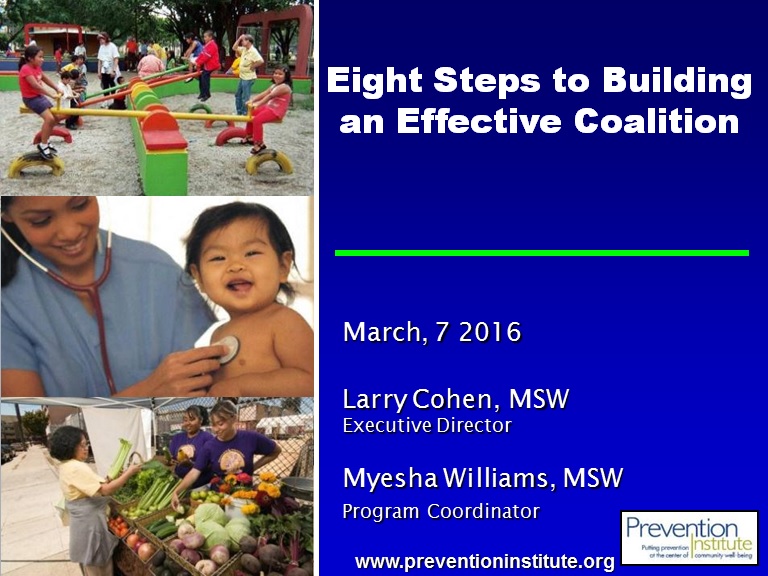NATIONAL ATR NETWORK SURVEY
Hundreds of ACEs, trauma, & resilience networks across the country responded to our survey. See what they shared about network characteristics, goals, and technical assistance needs.
Carpenters have table saws. Painters have camel-hair brushes. And social-change advocates have coalitions.
Coalitions—unions of people and organizations working to shape outcomes on a specific issue or problem—are tools, not ends in and of themselves. When they work effectively, they wield clout greater than the sum of their parts: They can broaden buy-in, tackle a broad range of goals, and benefit from the diverse viewpoints and strategies of their members.
They can also flounder, burn out, or become mired in turf struggles.
In a recent discussion with MARC communities, Larry Cohen and Myesha Williams of California’s Prevention Institute defined eight steps to consider when building or revitalizing a coalition. Their map can help guide a coalition at any stage of its growth:
Analyze your goals and decide whether or not to form a coalition. “Bringing people together and encouraging good interaction is important,” says Cohen, but it’s crucial to know your goals and state them clearly.
Find the right people. Assure equitable representation by recruiting those with diverse perspectives that reflect the needs of the community and that have a personal stake in the issues. For organizational members, consider both directors and front-line staff. Cohen notes that the deputy director, rather than the executive director, often has both the ability to engage and the authority to influence organizational decisions.
Develop preliminary objectives and activities. Consider projects that draw on members’ varied skills, offer opportunities for both short- and long-term successes, and address the whole range of prevention—from promoting individual well-being to informing policy.
Convene the coalition. Be specific with your meeting invitation and deliberate with the identification of key members. Cohen suggests a size of 10-16 people for ideal group process. When the coalition includes dozens of members, form a smaller steering committee and other sub-committees to maximize functioning.
Anticipate needed resources. This includes not only funding but also administrative skills, hosting facilities, research and data collection, planning and facilitation. Think of ways each member can contribute and be engaged.
Develop a successful coalition structure. An ad hoc, rather than ongoing, coalition may be crisper in its focus. Cohen suggests using a modified consensus process for decision-making driven by the question: Do most people agree with it and can everyone live with it? Think about what items—sub-committee reports, political updates, action plans—should be part of every agenda. And don’t forget breaks (with refreshments!) to boost informal interaction between members.
Keep the coalition vital. Cohen counsels addressing problems directly, paying attention to turf struggles, group dynamics and power differentials, flagging energy or external factors that have an impact on the coalition’s work. Be sure to welcome and engage new members with a clear orientation process.
Use evaluation to improve. At least once a year, examine and refine the coalition’s goals. Cohen suggests asking, “How good a coalition member are you?” and “How good a coalition are you part of?”
The Prevention Institute map was just the catalyst the Sonoma County ACEs Connection (SCAC) needed. Holly White-Wolfe, Analyst for the Sonoma County Department of Human Services, felt the nascent group would be more sustainable with a collaboration model that harnessed their bubbling grass-roots energy. With the County as the lead agency on the MARC grant, the collaboration could have tipped more towards a county-led model.
The MARC webinar on coalition-building, in which 13 SCAC members participated, crystalized the group’s choice of a coalition model. “We didn’t have a formal structure, co-chairs or guidelines,” said White-Wolfe. After the webinar, the group drafted a mission statement, appointed several temporary chairs and set a strategic planning session to further develop roles and structures.
That learning helped transform enthusiasm into effectiveness, White-Wolfe said. “People are really passionate about this work, and we needed a model that would allow for authentic community engagement. [The webinar] helped members realize that’s an umbrella they could fit under.”
Read Prevention Institute’s “Developing Effective Coalitions: An Eight-Step Guide” (2002)
See the slides from Prevention Institute’s webinar with the MARC learning collaborative on March 7, 2016.
Anndee Hochman is a journalist and author whose work appears regularly in The Philadelphia Inquirer, on the website for public radio station WHYY and in other print and online venues. She teaches poetry and creative non-fiction in schools, senior centers, detention facilities and at writers' conferences.
